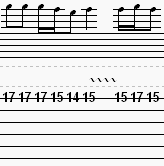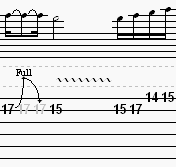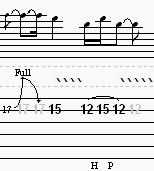Where to find this song – Night Moves track #6
Release Date – May 1978
Bob Seger developed into one of the most popular heartland rockers over the course of the ’70s. While he never attained the critical respect of his contemporary Bruce Springsteen, Seger did develop a dedicated following through constant touring with his Silver Bullet Band. Following several years of missed chances and lost opportunities, Seger finally achieved a national audience in 1976 with the back-to-back release of Live Bullet and Night Moves. After the platinum success of those albums, Seger held his popularity for the next two decades, releasing seven Top 10, platinum-selling albums in a row.
Intro Riff
Guitar 1

How To Play It

Don’t worry, you will only be playing two strings in this whole riff, so take your time and everything will be fine. Begin by placing your 4th finger on the “high E” string on the seventeenth fret. Play that three times, and then use your 2nd finger to play the fifteenth fret once. Then just use your 1st finger to play the fourteenth fret once, and then back with your 2nd finger to the fifteenth fret one time. Notice that on this note, there is a ribbon-like line above the notation. That will indicate the trill we talked about above. Perform that trill, and then use your 2nd finger again on the fifteenth fret. Then use your 4th finger to hit the seventeenth fret, and then finally your 2nd finger to finish the measure on the fifteenth fret. Ok, the first measure is done. Practice that a few times, and let’s move on to the second measure of this part.

The second measure is where you will be using the only other string in this riff, so focus for a second on the “B” string. Here you will be bending one full step on the seventeenth fret with your 4th finger. (Make it sound like the video). Then you will let the string back to its original positioning and use your 2nd finger to play the fifteenth fret. After the fifteenth fret, perform the trill as directed in the tablature and above. Then strike that note one more time, and use your 4th finger again for the seventeenth fret. Use your 1st finger to hit the fourteenth fret on the “high E” string again, and then your 2nd finger to play the fifteenth fret on the same string. That will end the second measure.

The third measure is much like the first, but there are some changes here. Begin by playing the seventeenth fret the same way as before, but on the first note, perform a trill instead of playing that seventeenth fret three times. The trill will take the place of the second note. Then just play the same fret once more, and proceed to the fifteenth fret as directed in the beginning. All of the rest of this measure is identical to the first.

The fourth measure starts out exactly like the second measure, so play that up until the fifteenth fret trill. Next, you will be performing a hammer-on, pull-off, AND trill all at the end of the measure. Don’t worry, we’ll walk you through it pretty easily. Begin this part by placing your 1st finger on the twelfth fret of the “B” string. Next, use your 3rd finger to hit the fifteenth fret and then let off of it quickly for the hammer. Then just play the twelfth fret again. Perform the trill a bit after you have played the twelfth fret the second time and you are done!
